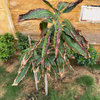Can Naranjilla (Solanum quitoense) be 'Pugged'?
CoPlantNut
12 years ago
More Discussions
Hello,
First-time poster on this list, but long-time lurker.
I received two Naranjilla (Solanum quitoense) seedlings last spring (Feb 2011) and tortured them in my temporary plant-growing areas for a few months until I was able to put them outside in early June, when we are finally (usually) free from frost.
Over the summer I managed to get the Naranjilla about 4 feet tall, with several dozen flowers blooming on 5-6 spikes before I had to haul them inside in late September to avoid frosts.
They then languished in my living room, with almost no light, until mid-December. I don't fault them for aborting all their fruits.
3 weeks ago I managed to finish my newest, and hopefully final (at this house, anyhow...) tropical plant growing area. I moved the Naranjilla plants in, along with the few other tropical fruits (miracle fruit, carambola, Barbados cherry, a few guavas, and some of my "Chilean Guava" (Ugni molinae).
Everything I've put in my new growing area (3 400-watt HID lights on a mover in my basement) has reacted very favorably. I only have clearance for plants up to about 70 inches (5'10), and the Naranjilla are rapidly approaching this.
Has anyone grown one of these before and brutally chopped it in half? There are many mostly-dormant buds along the base of the stems; I'm just wondering if a decapitation might cause issues with fruiting- there are many flower clusters forming along the highest growth, which would be chopped off.

hmhausman
trianglejohn
Related Professionals
Port Royal Landscape Architects & Landscape Designers · Salem Landscape Architects & Landscape Designers · Newcastle Landscape Architects & Landscape Designers · Bellefontaine Neighbors Landscape Contractors · Belmont Landscape Contractors · Davis Landscape Contractors · Laguna Hills Landscape Contractors · Pine Hills Landscape Contractors · Pomona Landscape Contractors · Wallingford Landscape Contractors · Watertown Landscape Contractors · Wells Landscape Contractors · West Palm Beach Landscape Contractors · Palos Hills Landscape Contractors · New Carrollton Landscape ContractorsCoPlantNutOriginal Author
trianglejohn
CoPlantNutOriginal Author